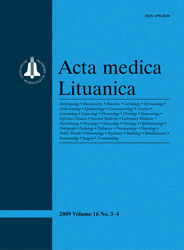 ISSN 1392-0138 ISSN 2029-4174 (online) |
2008 m. Nr. 1 Morphofunctional characteristics of students of Moscow Suvorov Military School
Background. Analysis of factors determining patterns of growth processes in adolescents still remains a matter of great interest. One of the possible ways to identify those factors is to carry out a comparative group analysis, where living conditions may be regarded as relatively standard and regulated in respect of food structure and calorie content, motion activity level etc. This approach may be realized in the study of children from specialized educational institutions. Materials and methods. In 2006, 255 boys aged from 14 to 17 were investigated cross-sectionally in Moscow Suvorov Military School (SMS). The results were compared with the previously investigated students of Moscow municipal schools and those of special sports schools of the same age range. The program included anthropometric measurements, evaluation of sexual maturation indices, somatotypes, diastolic and systolic blood pressure, pulse rate, hand grip etc. For the study of body composition, the bioelectrical impedance analysis (BIA) was used. Results. Significant differences were found in somatic and functional traits between the three groups studied. These differences were explained in the first place by social and demographic factors that influenced the samples under analysis. 75% of children in the 1st and 2nd groups were represented by those born in Moscow, while in the 3rd group (SMS) a similar figure Conclusions. Thus, social factors have determined the differences in the course of microevolutionary changes between groups: in particular, the brachimorphic body build and brachicephalization in SMS group as compared to the students from the other two groups. Keywords: auxology, physical development, body composition, students of military schools, social factors |
Issues:
2011 - Vol.18 No. 1, No. 2, No. 3, No. 4 2010 - Vol.17 No. 1-2, No. 3-4 2009 - Vol.16 No. 1-2, No. 3-4 2008 - Vol.15 No. 1, No. 2, No. 3, No. 4 2007 - Vol.14 No. 1, No. 2, No. 3, No. 4 2006 - Vol.13 No. 1, No. 2, No. 3, No. 4 2005 - Vol.12 No. 1, No. 2, No. 3, No. 4 2004 - Vol.11 No. 1, No. 2, No. 3, No. 4 2003 - Vol.10 No. 1, No. 2, No. 3, No. 4 2002 - Vol.9 No. 1, No. 2, No. 3, No. 4 2001 - Vol.8 No. 1, No. 2, No. 3, No. 4 |